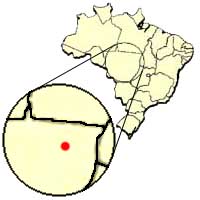
Xingu National Park
Encyclopedia

Xingu peoples
Xingui peoples are indigenous peoples of Brazil living near the Xingu River. They have many cultural similarities despite their different ethnologies...
is located in the state of Mato Grosso
Mato Grosso
Mato Grosso is one of the states of Brazil, the third largest in area, located in the western part of the country.Neighboring states are Rondônia, Amazonas, Pará, Tocantins, Goiás and Mato Grosso do Sul. It also borders Bolivia to the southwest...
, Brazil
Brazil
Brazil , officially the Federative Republic of Brazil , is the largest country in South America. It is the world's fifth largest country, both by geographical area and by population with over 192 million people...
and was created on April 14, 1961, signed by President Jânio Quadros
Jânio Quadros
Jânio da Silva Quadros , , was a Brazilian politician who served as President of Brazil for only 7 months in 1961.-Career:...
. The area of the park is 2,642,003 ha.(26,420 km²), and it is contained in the municipalities of Mato Grosso; Canarana, Paranatinga, São Félix do Araguaia, São José do Xingu, Gaúcha do Norte, Feliz Natal, Querência, União do Sul, Nova Ubiratã and Marcelândia.

The tribes which are present includes (population as of 2002) Kamayurá
Kamayurá people
The Kamayurá are an indigenous tribe in the Amazonian Basin of Brazil. The name is also spelled Kamayura, and Kamaiurá in Portuguese; it means "a raised platform to keep meat, pots and pans." The Kamayurá language belongs to the Tupi–Guarani family...
(355), Kaiabi
Kaiabi
The Kaiabi are an indigenous people inhabiting the northern Brazilian state of Mato Grosso, more precisely in the Xingu Indigenous Park and the Indian Reservation of Apiaká-Kayabi south of Pará. The Kaiabi speak a language of Tupi-Guarani family. They have a population of 1,619 .- External links :*...
(745), Yudjá
Yudjá
The Yudjá, also called the Juruna, Juruhuna, Yuruna, Juruûna, Geruna, and Yudya, are an indigenous people who live in the states of Mato Grosso and Pará, Brazil. They have a population of 362 , up from a low of 37 in 1950.-Further reading:...
(248), Aweti
Aweti
The Aweti people are a group of Native Americans living in the Xingu Indigenous Park, close to the headwaters of the Xingu River in Brazil. The Aweti inhabit two villages in the region. One is called Tazu’jyretam, and the other is unnamed. Tazu’jyretam is the main village of the Aweti people,...
(138), Mehinako
Mehinako
The Mehinako, Mehinaku, Mehináku, or Meinacos are members of an indigenous group located in the region around the headwaters of the Xingu River in Brazil. They speak an Arawakan language and currently reside in area around the Tuatuari and Kurisevo rivers...
(199), Wauja
Wauja
The Wauja are an Aruak speaking tribe located in the region around the Upper Xingu River.They have a population of 487 .-History:The Wauja and Mehinako, two Aruak speaking tribes native to the Upper Xingu River, are likely descendants of various tribes which came into the region in roughly the 9th...
(321), Yawalapiti
Yawalapiti
The Yawalapiti are an indigenous tribe in the Amazonian Basin of Brazil. The name is also spelled Yawalapiti, and Iaualapiti in Portuguese. The current village Yawalapiti is situated more to the south, between the Tuatuari and Kuluene River. The Yawalapiti language belongs to the Arawakan family...
(208), Ikpeng
Ikpeng
The Ikpeng are a Carib-speaking tribe located near the Upper Xingu River. They have a population of 459 , up from a low of 50 in 1969.-History:...
(319), Kalapalo
Kalapalo
The Kalapalo are one of the seventeen Brazilian indigenous tribes who inhabit the Xingu National Park in the Upper Xingu river region of the Brazilian state of Mato Grosso. They are also one of the four peoples speaking Cariban languages in the area. They have a population of 569...
(417), Kuikuro
Kuikuro
The Kuikuro are an indigenous ethnic group from the Mato Grosso region of Brazil. Their language, Kuikuro, is a part of the Karib language family. The Kuikuro have many similarities with other Xingu tribes...
(415), Matipu
Matipu
The Matipu are an ethnic group close to extinction in Brazil which has a population estimated at about 127 individuals in 2010, they had a population of 40 in the 1995 census. They speak the Matipu language of the Carib family and are mainly of animist faith.They live in the Brazilian state of...
(119), Nahukwá (105), Suyá
Suya
Suya, is a shish kebab like food popular in West Africa, originally from the Hausa people of northern Nigeria and Niger. Suya is generally made with skewered beef, fish, or chicken. The meat is rubbed-in with tankora, a dry spice mix containing powdered groundnuts, cayenne pepper, ginger, paprika...
(334) and Trumai
Trumai
The Trumai are an indigenous group in Brazil. They currently reside within the Xingu National Park, in the state of Matto Grosso...
(120). The population is growing at 3% per year.
Part of the intrigue of the Xingu area is the drama associated with early-20th century exploration by Europeans, among whom perhaps Percy Harrison Fawcett is most notable. He sought out a city rumored since early 16th century European contact. David Grann
David Grann
David Grann is an American literary journalist and best-selling author. He has written about a range of subjects, from New York City's antiquated water supply system to the hunt for giant squid to the U.S...
's book, The Lost City of Z
The Lost City of Z (book)
The Lost City of Z: A Tale of Deadly Obsession in the Amazon is a non-fiction book by American author David Grann. It tells the story of the legendary British explorer Percy Fawcett who, in 1925, disappeared with his son in the Amazon while looking for an ancient lost city. For decades, explorers...
documents not only those early explorations, but more recent findings supporting the concept of large-scale civilizations pre-dating Spanish and Portuguese contacts.

